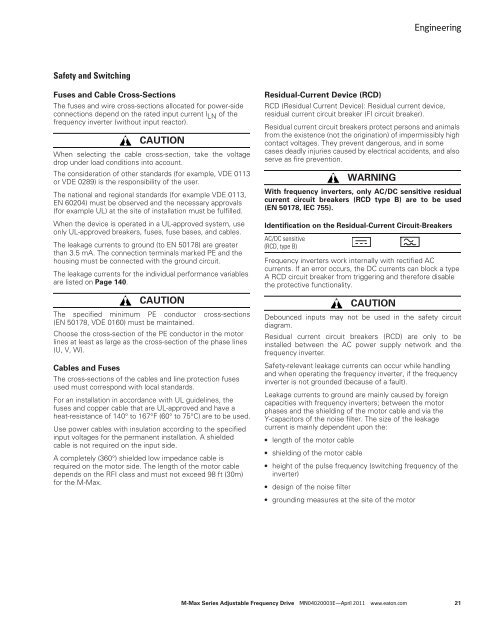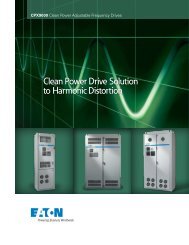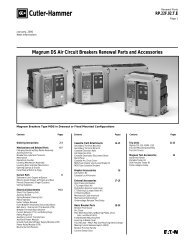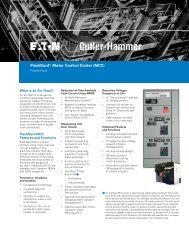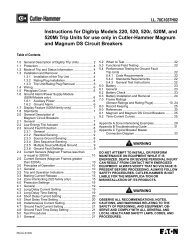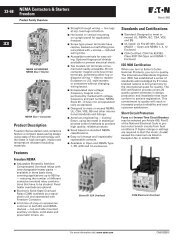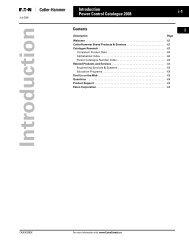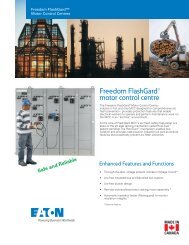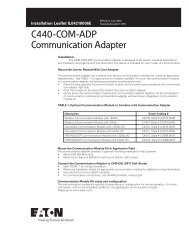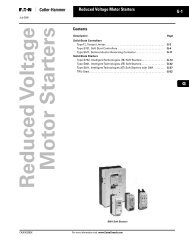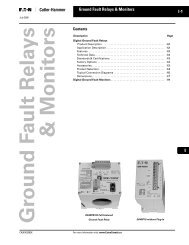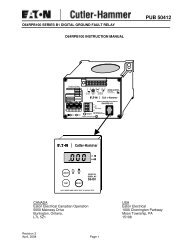M-Maxâ„¢ Series Adjustable Frequency Drive - Eaton Corporation
M-Maxâ„¢ Series Adjustable Frequency Drive - Eaton Corporation
M-Maxâ„¢ Series Adjustable Frequency Drive - Eaton Corporation
Create successful ePaper yourself
Turn your PDF publications into a flip-book with our unique Google optimized e-Paper software.
Safety and Switching<br />
Fuses and Cable Cross-Sections<br />
The fuses and wire cross-sections allocated for power-side<br />
connections depend on the rated input current I LN of the<br />
frequency inverter (without input reactor).<br />
CAUTION<br />
When selecting the cable cross-section, take the voltage<br />
drop under load conditions into account.<br />
The consideration of other standards (for example, VDE 0113<br />
or VDE 0289) is the responsibility of the user.<br />
The national and regional standards (for example VDE 0113,<br />
EN 60204) must be observed and the necessary approvals<br />
(for example UL) at the site of installation must be fulfilled.<br />
When the device is operated in a UL-approved system, use<br />
only UL-approved breakers, fuses, fuse bases, and cables.<br />
The leakage currents to ground (to EN 50178) are greater<br />
than 3.5 mA. The connection terminals marked PE and the<br />
housing must be connected with the ground circuit.<br />
The leakage currents for the individual performance variables<br />
are listed on Page 140.<br />
CAUTION<br />
The specified minimum PE conductor cross-sections<br />
(EN 50178, VDE 0160) must be maintained.<br />
Choose the cross-section of the PE conductor in the motor<br />
lines at least as large as the cross-section of the phase lines<br />
(U, V, W).<br />
Cables and Fuses<br />
The cross-sections of the cables and line protection fuses<br />
used must correspond with local standards.<br />
For an installation in accordance with UL guidelines, the<br />
fuses and copper cable that are UL-approved and have a<br />
heat-resistance of 140° to 167°F (60° to 75°C) are to be used.<br />
Use power cables with insulation according to the specified<br />
input voltages for the permanent installation. A shielded<br />
cable is not required on the input side.<br />
A completely (360°) shielded low impedance cable is<br />
required on the motor side. The length of the motor cable<br />
depends on the RFI class and must not exceed 98 ft (30m)<br />
for the M-Max.<br />
M-Max <strong>Series</strong> <strong>Adjustable</strong> <strong>Frequency</strong> <strong>Drive</strong><br />
Residual-Current Device (RCD)<br />
MN04020003E—April 2011 www.eaton.com<br />
Engineering<br />
RCD (Residual Current Device): Residual current device,<br />
residual current circuit breaker (FI circuit breaker).<br />
Residual current circuit breakers protect persons and animals<br />
from the existence (not the origination) of impermissibly high<br />
contact voltages. They prevent dangerous, and in some<br />
cases deadly injuries caused by electrical accidents, and also<br />
serve as fire prevention.<br />
WARNING<br />
With frequency inverters, only AC/DC sensitive residual<br />
current circuit breakers (RCD type B) are to be used<br />
(EN 50178, IEC 755).<br />
Identification on the Residual-Current Circuit-Breakers<br />
AC/DC sensitive<br />
(RCD, type B)<br />
<strong>Frequency</strong> inverters work internally with rectified AC<br />
currents. If an error occurs, the DC currents can block a type<br />
A RCD circuit breaker from triggering and therefore disable<br />
the protective functionality.<br />
CAUTION<br />
Debounced inputs may not be used in the safety circuit<br />
diagram.<br />
Residual current circuit breakers (RCD) are only to be<br />
installed between the AC power supply network and the<br />
frequency inverter.<br />
Safety-relevant leakage currents can occur while handling<br />
and when operating the frequency inverter, if the frequency<br />
inverter is not grounded (because of a fault).<br />
Leakage currents to ground are mainly caused by foreign<br />
capacities with frequency inverters; between the motor<br />
phases and the shielding of the motor cable and via the<br />
Y-capacitors of the noise filter. The size of the leakage<br />
current is mainly dependent upon the:<br />
●<br />
●<br />
●<br />
●<br />
●<br />
length of the motor cable<br />
shielding of the motor cable<br />
height of the pulse frequency (switching frequency of the<br />
inverter)<br />
design of the noise filter<br />
grounding measures at the site of the motor<br />
21


